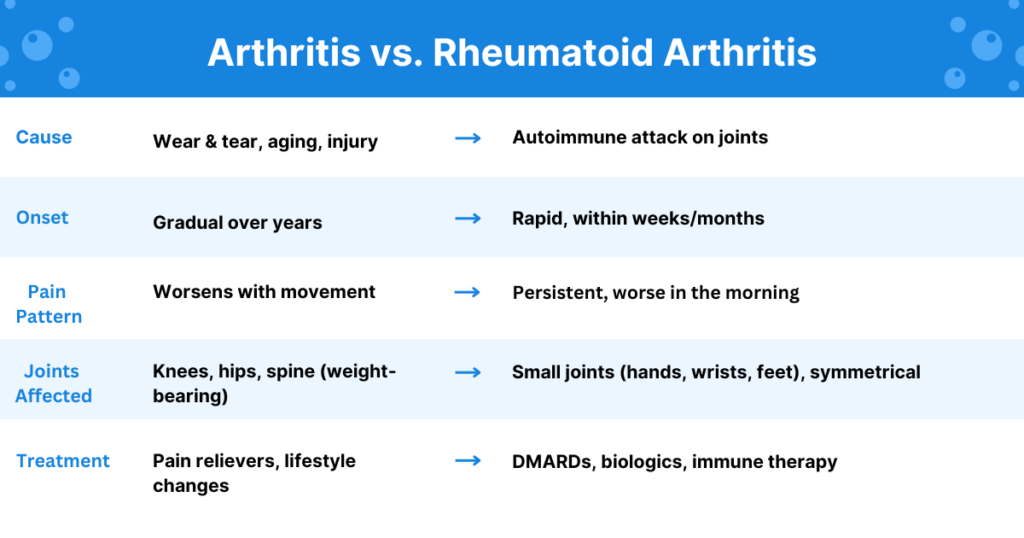As a rheumatologist, I often come across patients who are confused about the difference between arthritis and rheumatoid arthritis. Many assume that they are interchangeable terms, but in reality, they are distinct conditions with different causes, symptoms, and treatment approaches. Understanding these differences is crucial for accurate diagnosis and effective management.
What is Arthritis?
Arthritis is a broad term that encompasses over 100 different types of joint-related diseases. It refers to inflammation in one or more joints, leading to pain, stiffness, and reduced mobility. The most common types include osteoarthritis (OA), rheumatoid arthritis (RA), psoriatic arthritis, gout, and lupus-related arthritis.
The primary cause of arthritis varies depending on the type. For instance, osteoarthritis, the most prevalent form, is primarily caused by wear and tear of the joints over time. On the other hand, inflammatory arthritis, such as rheumatoid arthritis, results from an overactive immune response.
What is Rheumatoid Arthritis?
Rheumatoid arthritis (RA) is a distinct type of arthritis classified as an autoimmune disease. Unlike osteoarthritis, which results from wear and tear, RA occurs when the immune system mistakenly attacks the synovium, the protective lining of the joints. This leads to persistent inflammation, causing pain, swelling, and long-term joint damage. If left untreated, RA can also impact other organs like the heart, lungs, and eyes, making early diagnosis and management essential.
Key Differences Between Arthritis and Rheumatoid Arthritis

1. Cause and Nature of the Disease
- Arthritis is a broad term covering multiple joint diseases with different causes. It can stem from mechanical wear (as in osteoarthritis), infections, metabolic imbalances, or autoimmune dysfunctions.
- Rheumatoid arthritis, specifically, is an autoimmune condition where the immune system attacks healthy joint tissues.
2. Onset and Progression
- Osteoarthritis, the most common form of arthritis, develops gradually over years due to cartilage breakdown.
- Rheumatoid arthritis can develop rapidly over weeks or months and often starts with systemic symptoms such as fatigue and fever before joint pain begins.
3. Symptom Patterns
- General arthritis symptoms include joint pain, stiffness, swelling, and reduced range of motion.
- Rheumatoid arthritis symptoms are symmetrical, meaning if one knee or hand is affected, the other is likely to be as well. Additionally, RA is often associated with morning stiffness that lasts for an hour or more.
4. Joint Involvement
- Osteoarthritis typically affects weight-bearing joints such as the knees, hips, and spine.
- Rheumatoid arthritis commonly affects smaller joints first, such as those in the fingers, wrists, and feet, before progressing to larger joints.
5. Systemic Effects
- Most types of arthritis are localized to the joints.
- Rheumatoid arthritis can have systemic effects, impacting the heart, lungs, skin, eyes, and even blood vessels.
6. Risk Factors
- Risk factors for osteoarthritis include aging, joint injury, obesity, and genetics.
- Rheumatoid arthritis risk factors include genetic predisposition, smoking, gender (women are more commonly affected), and environmental triggers.
7. Diagnosis and Testing
- Diagnosis of general arthritis depends on clinical symptoms and imaging tests like X-rays or MRIs.
- Rheumatoid arthritis diagnosis involves blood tests to check for markers like rheumatoid factor (RF), anti-CCP antibodies, and elevated inflammatory markers such as ESR and CRP, in addition to imaging.
8. Best treatment for rheumatoid arthritis Approaches
- Treatment for osteoarthritis includes pain relief medications, physical therapy, lifestyle modifications, and in severe cases, joint replacement surgery.
- Rheumatoid arthritis requires disease-modifying antirheumatic drugs (DMARDs), biologics, and corticosteroids to control the immune response and prevent joint damage.
Why Understanding These Differences Matters
Misconceptions about arthritis and rheumatoid arthritis can delay proper diagnosis and treatment. Many patients come to me believing that arthritis is just a part of aging and that nothing can be done about it. However, early intervention, especially in rheumatoid arthritis, can significantly improve outcomes and prevent irreversible joint damage.
For those experiencing persistent joint pain, swelling, or stiffness, I always emphasize the importance of seeking medical evaluation. A proper diagnosis ensures that you receive the most effective treatment tailored to your specific condition.
Managing Arthritis and Rheumatoid Arthritis
While arthritis and rheumatoid arthritis are different in their causes and progression, managing them effectively requires a combination of medical treatments and lifestyle changes. Here are some strategies I recommend:
- Stay Active: Regular, low-impact exercise like swimming, walking, and yoga can help maintain joint flexibility and reduce stiffness.
- Healthy Diet: An anti-inflammatory diet rich in omega-3 fatty acids, fruits, and vegetables can help manage symptoms.
- Weight Management: Excess weight puts additional stress on joints, particularly in osteoarthritis. Maintaining a healthy weight can slow disease progression.
- Medication Compliance: For rheumatoid arthritis, adherence to prescribed DMARDs and biologics is essential to prevent disease progression.
- Physical Therapy: A tailored exercise plan from a physiotherapist can help strengthen muscles around the joints, improving stability and function.
- Regular Check-Ups: Monitoring disease progression and adjusting treatment plans as needed ensures better management of both conditions.
FAQ: Arthritis and Rheumatoid Arthritis
1.What is the main difference between arthritis and rheumatoid arthritis?
Arthritis is a broad term for joint diseases, while rheumatoid arthritis (RA) is an autoimmune condition that attacks the joints.
2.What are the early signs of rheumatoid arthritis?
Morning stiffness, joint pain, swelling, fatigue, and symmetrical joint involvement (both hands, wrists, or feet).
3.Can arthritis be cured?
No, but symptoms can be managed with medications, lifestyle changes, and therapy.
4. Which joints are most affected by arthritis and Rheumatoid arthritis?
Arthritis mainly affects weight-bearing joints (knees, hips, spine); RA targets smaller joints (hands, wrists, feet) first.
5. What are the best treatments for arthritis and rheumatoid arthritis?
Arthritis: Pain relief, exercise, weight management, physical therapy.
Rheumatoid arthritis: DMARDs, biologics, steroids, lifestyle modifications.
6.How can I prevent arthritis and rheumatoid arthritis from worsening?
Early diagnosis, proper medications, an active lifestyle, and a healthy diet can slow progression.
7.Can diet help manage arthritis and Rheumatoid arthritis?
Yes! Anti-inflammatory foods like omega-3s, fruits, and vegetables can help reduce symptoms.
Conclusion
Arthritis and rheumatoid arthritis may share some symptoms, but they are fundamentally different conditions requiring distinct treatment approaches. While arthritis is a broad term for joint diseases, rheumatoid arthritis is an aggressive autoimmune disorder that can lead to severe joint damage and systemic complications if left untreated.
The good news? With early diagnosis, proper treatment, and lifestyle changes, both conditions can be managed effectively. Don’t ignore persistent joint pain or stiffness seek expert advice, take proactive steps, and reclaim control over your mobility and quality of life.
“ Early treatment leads to better outcomes and improved quality of life. ’’





